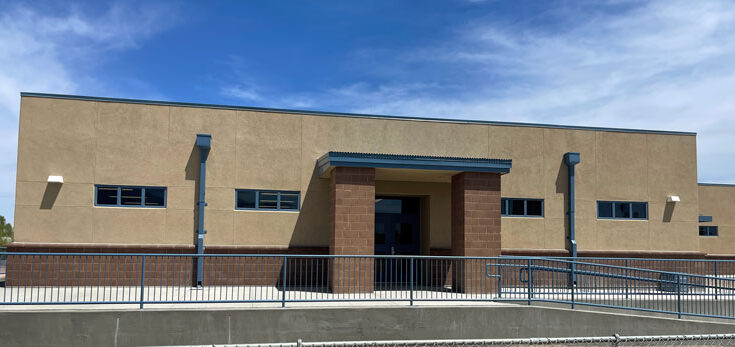Jon Johnson Photo/Gila Herald: The Pima School District’s 16,000-square-foot new elementary addition opened last year to help accommodate student growth.
Op-Ed By Sean Rickert/Pima School District Superintendent
The Arizona State Board of Education has issued letter grades for public schools as required by law. These grades are an effort to identify schools that are doing well and schools that are struggling. They are not measures of individual teachers, students, or even communities. While most of the elementary schools in the county received a “B”, and most high schools received an “A”, there is one notable exception. Pima Elementary School received an “F”. Some explanation is owed to parents and our community for this outcome. Hopefully, we can develop a shared understanding of the reasons behind the poor grade. This isn’t about pointing fingers or making excuses. We need to know why things happen, so we can remain confident that the steps being taken will yield better outcomes. Providing a clear understanding of what those steps are is also important. This is a complicated issue, but for this explanation, we need to keep things consumable. Deeper questions will need to be addressed elsewhere.
Sometimes things go wrong. The 2021-2022 school year was a perfect storm for Pima Elementary School, and the letter grade reflects this. Three elements can be linked to the debacle. These elements are a poor recovery from the disruptions of the pandemic, a high number of novice teachers, and weak curriculum adoption and implementation in key areas. These three factors combined to reduce the effectiveness of the program, and student achievement reflects it.
The pandemic caused significant disruption to how schools operate. After restrictions were lifted, a second transition occurred. Unfortunately, this shift was not seamless. During the fall semester, we experienced many failed initiatives. These hurt efforts to serve students. A schedule was put into place that lacked collaborative effort, which led to multiple roadblocks and various alterations had to be made. This created great instability in our Tier 2 (below grade level) and Tier 3 (significantly below grade level) interventions. This continued throughout much of the first semester. This along with the reduced level of teacher experience diminished our overall effectiveness, but that is still not all.
In response to the pandemic, the federal government poured vast amounts of funding into schools. Pima used those funds to reduce class sizes by adding teaching positions. To fill these positions teachers were hired who were, or are still in teacher preparation programs. This isn’t uncommon. One-third of classroom teachers in Arizona lack appropriate certification. We made things harder as veteran teachers, completely exhausted having worked through COVID were tasked with mentoring novice teachers, and the principal had to identify and address weaknesses. This created a challenge, but that alone would not result in an “F”. Other factors contributed as well.
The basic framework guiding classroom instruction is the curriculum. Fifty years ago the curriculum was developed by each teacher. But, the era of standardized testing has given us a very standardized curriculum. Not all curriculum is of the same quality, and a high-quality curriculum is only effective if teachers know how to use it well. Last year we found ourselves with an old math curriculum that most teachers were not trained to use and many did not like. We were also implementing a new reading curriculum our teachers were excited about but were unfamiliar with because they did not receive adequate training. Again, we see factors reducing the effectiveness of the academic program.
When things go horribly wrong, it is never the result of just one error. An increased number of novice teachers, a botched transition from restrictive practices to the ”new normal”, or the challenge of an old unpopular curriculum and a new unfamiliar curriculum would be part of the normal struggle. Schools that have none of these types of struggles get “A” labels, those with some get B’s and C’s and those coping with many get D’s and even F’s.
How are we addressing these challenges? Our goal is to move toward a high-quality education. We have taken four key steps to make this happen– increasing our level of teacher experience, expanding teacher involvement in decision-making, support for teachers on curriculum implementation and adoption, and bringing in support for our teachers. Some of these steps are being taken to address the weaknesses we have discussed. Others are aimed at ensuring we are in a better position going forward. Nothing contributes to student success like an excellent teacher. Pima has the best teachers you will find anywhere. Every teacher has the potential to be better next year than they are right now. We are working to provide both the motivation and the opportunities for our teachers to maximize growth – growth as professionals and growth in student knowledge. At the same time, we continue to strive to retain the great teachers we have. We are supportive of their life-work balance while we strive to attract new experienced teachers with competitive compensation packages.
Our teachers are great and continue to get better every year. Those teachers are not only valuable because they instruct our students. Also, they are important participants in our decision-making process. Better communication helps us to identify challenges and develop effective solutions when adjustments are necessary. This is essential if we are to keep challenges from diminishing our ability to meet student needs.
This year we have put in place content specialists, in math and literacy, at the Elementary School. These are veteran teachers who have pursued additional training in their subject area to help them support other teachers. Part of their job is getting into classrooms and working with teachers to better implement the curriculum. They are also involved in reviewing the effectiveness of existing curricula and piloting new curricula. So, teachers are never left alone to figure out how to use the tools they are given. It also means we are reviewing the effectiveness of our curriculum based on implementation and quality. To help us accomplish all of this we are going to use tried and true methods to improve our school. The normal pattern for supporting school improvement is to wait until a year has passed. Then the state comes in and demands changes. Instead, we are gathering available resources to take our commitment to do better and build momentum that will propel us far beyond where we have been in the past. A three-pronged effort made up of experienced consultants, internal leadership, and support to motivate and assist individual teachers will all be funded through an existing public-private partnership developed by Governor Ducey’s office. This program will help us to do what we are already planning to accomplish with even greater effectiveness.
We could waste time bemoaning the invalidity of the state letter grade system or pointing fingers at individuals to place blame for the current letter grade. Unfortunately, the combination of a high number of novice teachers, poorly implemented adjustments to post-pandemic practices that failed to support teacher and student needs, and a weak curriculum has put us in a difficult position. Nobody likes to get an ‘F’. In the end, I bare the burden and take responsibility for these failures. . My goal is to find the best way forward, and if it is possible, to turn our lemons into lemonade. Through discussions with district leaders, I have developed an understanding of what has gone wrong. The next step has been to find the simple things we can do to overcome the challenges bringing us down. This isn’t hard to do, especially when you have a team of professionals wanting to achieve the highest possible outcomes. Bringing significant funding to bear to ensure those who will work hard to make things better are compensated without having to make cuts elsewhere, is also my responsibility. We will make it happen. Hopefully, you can see that we have a plan to move forward in our effort to ensure every student at Pima Schools receives a high-quality education in a safe and nurturing environment, in partnership with parents and our community.








